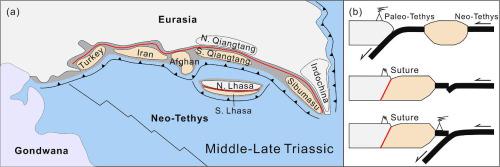Gondwana Research ( IF 6.1 ) Pub Date : 2021-09-06 , DOI: 10.1016/j.gr.2021.08.012 Xuhui Wang 1 , Xinghai Lang 1 , Reiner Klemd 2 , Yulin Deng 1 , Juxing Tang 3

|
Collision-induced subduction transference may have triggered subduction of the Neo-Tethys oceanic lithosphere. To verify this proposition, we present an integrated geochemical and geochronological studies of new and published data of the Permian-Triassic magmatism in the Lhasa Terrane. The newly identified Chongni mafic intrusions (gabbros and diorites) in the North Lhasa Terrane (NLT) were emplaced during the Early Permian (ca. 275 Ma). The mafic rocks have (87Sr/86Sr)t ratios between 0.7037 and 0.7042, and εNd(t) values between +5.2 and +5.8. The zircons of the Chongni mafic rock samples have εHf(t) values from +9.1 to +12.9. The isotopic data in conjunction with trace element features suggest that the Chongni mafic intrusions have been derived mainly by partial melting of a metasomatized mantle wedge source. The newly identified Quxu granodiorites and hornblende gabbros in the South Lhasa Terrane (SLT) were emplaced in the Late Triassic (ca. 228–203 Ma). The granodiorites are characterized by (87Sr/86Sr)t ratios of 0.7036–0.7037 and εNd(t) values of +6.6 to +6.7, while the hornblende gabbro samples have (87Sr/86Sr)t ratios of 0.7033–0.7035 and εNd(t) values of +7.3 to +7.4. The zircons of the granodiorite and hornblende gabbro samples revealed εHf(t) values of +10.3 to +14.0 and +10.8 to +16.4, respectively. The isotopic data in combination with trace element signatures suggest that the granodiorites were derived from a juvenile basaltic lower crust with a minor input of mantle components, while the hornblende gabbros are interpreted to have formed during partial melting of a formerly metasomatized depleted mantle wedge source. The Early Permian and Late Triassic magmatic rocks consistently show arc-related signatures, which probably record the northward subduction of the Sumdo Paleo-Tethys and the Neo-Tethys oceanic slabs, respectively. This evidence, in combination with that of other studies on the Permian-Triassic magmatism across the Lhasa Terrane, indicates that arc magmatism within the NLT switched to collisional magmatism at ca. 260 Ma due to the collision of oceanic islands/plateaus and, further on, the collision of the SLT with the NLT. Furthermore, the change from ca. 265–255 Ma alkaline magmatism to ca. 240–200 Ma calc‐alkaline magmatism within the SLT may reflect the geodynamic transition from lithospheric extension to Andean-style orogenesis. Therefore, we propose that subduction initiation of the Neo-Tethys oceanic lithosphere in the Tibetan Plateau resulted from the southward transference of the Sumdo Paleo-Tethys subduction zone, involving the collision of oceanic islands/plateaus and, subsequently, the collision of the SLT with the NLT. Additionally, the geological records of the Tethyan orogenic system suggest that the subduction initiation of the Neo-Tethys oceanic lithosphere is a uniform response to the collision between Cimmeria and Eurasia.
中文翻译:

碰撞诱导俯冲转移引发新特提斯大洋岩石圈俯冲
碰撞引起的俯冲转移可能触发了新特提斯大洋岩石圈的俯冲。为了验证这一命题,我们对拉萨地体二叠纪-三叠纪岩浆活动的新的和已发表的数据进行了综合地球化学和地质年代学研究。北拉萨地体(NLT)新发现的冲泥镁铁质侵入体(辉长岩和闪长岩)是在早二叠世(约 275 Ma)就位的。基性岩的 ( 87 Sr/ 86 Sr) t比值介于 0.7037 和 0.7042 之间,ε Nd ( t ) 值介于 +5.2 和 +5.8 之间。冲泥基性岩样锆石的ε Hf ( t) 值从 +9.1 到 +12.9。同位素数据结合微量元素特征表明,冲泥基性侵入体主要来源于交代地幔楔源的部分熔融。拉萨南地体(SLT)中新发现的曲徐花岗闪长岩和角闪辉长岩位于晚三叠世(约228-203 Ma)。花岗闪长岩的 ( 87 Sr/ 86 Sr) t比值为 0.7036–0.7037,ε Nd ( t ) 值为 +6.6 至 +6.7,而角闪长岩样品的 ( 87 Sr/ 86 Sr) t比值为 3–7。 0.7035 和 ε Nd ( t) +7.3 到 +7.4 的值。花岗闪长岩和角闪辉长岩样品的锆石显示 ε Hf ( t) 值分别为 +10.3 至 +14.0 和 +10.8 至 +16.4。同位素数据与微量元素特征相结合,表明花岗闪长岩来自年轻的玄武岩下地壳,地幔成分输入较少,而角闪长岩被解释为在先前交代的耗尽地幔楔源部分熔融期间形成。早二叠世和晚三叠世岩浆岩一致显示弧相关特征,这可能分别记录了苏姆多古特提斯和新特提斯洋板块向北俯冲。这一证据与其他关于跨越拉萨地体的二叠纪-三叠纪岩浆作用的研究相结合,表明 NLT 内的弧岩浆作用在约 由于海洋岛屿/高原的碰撞,以及 SLT 与 NLT 的碰撞,260 Ma。此外,从大约变化。265-255 Ma 碱性岩浆作用到约。SLT内240-200 Ma钙碱性岩浆活动可能反映了从岩石圈伸展到安第斯式造山作用的地球动力学转变。因此,我们认为青藏高原新特提斯大洋岩石圈的俯冲起始是由松多古特提斯俯冲带向南转移引起的,包括大洋岛/高原的碰撞以及随后的SLT与NLT。此外,特提斯造山系统的地质记录表明,新特提斯大洋岩石圈的俯冲开始是对辛梅里亚和欧亚大陆碰撞的统一反应。SLT 与 NLT 的冲突。此外,从大约变化。265-255 Ma 碱性岩浆作用到约。SLT内240-200 Ma钙碱性岩浆活动可能反映了从岩石圈伸展到安第斯式造山作用的地球动力学转变。因此,我们认为青藏高原新特提斯大洋岩石圈的俯冲起始是由松多古特提斯俯冲带向南转移引起的,包括大洋岛/高原的碰撞以及随后的SLT与NLT。此外,特提斯造山系统的地质记录表明,新特提斯大洋岩石圈的俯冲开始是对辛梅里亚和欧亚大陆碰撞的统一反应。SLT 与 NLT 的冲突。此外,从大约变化。265-255 Ma 碱性岩浆作用到约。SLT内240-200 Ma钙碱性岩浆活动可能反映了从岩石圈伸展到安第斯式造山作用的地球动力学转变。因此,我们认为青藏高原新特提斯大洋岩石圈的俯冲起始是由松多古特提斯俯冲带向南转移引起的,包括大洋岛/高原的碰撞以及随后的SLT与NLT。此外,特提斯造山系统的地质记录表明,新特提斯大洋岩石圈的俯冲开始是对辛梅里亚和欧亚大陆碰撞的统一反应。265-255 Ma 碱性岩浆作用到约。SLT内240-200 Ma钙碱性岩浆活动可能反映了从岩石圈伸展到安第斯式造山作用的地球动力学转变。因此,我们认为青藏高原新特提斯大洋岩石圈的俯冲起始是由松多古特提斯俯冲带向南转移引起的,包括大洋岛/高原的碰撞以及随后的SLT与NLT。此外,特提斯造山系统的地质记录表明,新特提斯大洋岩石圈的俯冲开始是对辛梅里亚和欧亚大陆碰撞的统一反应。265-255 Ma 碱性岩浆作用到约。SLT内240-200 Ma钙碱性岩浆活动可能反映了从岩石圈伸展到安第斯式造山作用的地球动力学转变。因此,我们认为青藏高原新特提斯大洋岩石圈的俯冲起始是由松多古特提斯俯冲带向南转移引起的,包括大洋岛/高原的碰撞以及随后的SLT与NLT。此外,特提斯造山系统的地质记录表明,新特提斯大洋岩石圈的俯冲开始是对辛梅里亚和欧亚大陆碰撞的统一反应。SLT内240-200 Ma钙碱性岩浆活动可能反映了从岩石圈伸展到安第斯式造山作用的地球动力学转变。因此,我们认为青藏高原新特提斯大洋岩石圈的俯冲起始是由松多古特提斯俯冲带向南转移引起的,包括大洋岛/高原的碰撞以及随后的SLT与NLT。此外,特提斯造山系统的地质记录表明,新特提斯大洋岩石圈的俯冲开始是对辛梅里亚和欧亚大陆碰撞的统一反应。SLT内240-200 Ma钙碱性岩浆活动可能反映了从岩石圈伸展到安第斯式造山作用的地球动力学转变。因此,我们认为青藏高原新特提斯大洋岩石圈的俯冲起始是由松多古特提斯俯冲带向南转移引起的,包括大洋岛/高原的碰撞以及随后的SLT与NLT。此外,特提斯造山系统的地质记录表明,新特提斯大洋岩石圈的俯冲开始是对辛梅里亚和欧亚大陆碰撞的统一反应。涉及海洋岛屿/高原的碰撞,以及随后的 SLT 与 NLT 的碰撞。此外,特提斯造山系统的地质记录表明,新特提斯大洋岩石圈的俯冲开始是对辛梅里亚和欧亚大陆碰撞的统一反应。涉及海洋岛屿/高原的碰撞,以及随后的 SLT 与 NLT 的碰撞。此外,特提斯造山系统的地质记录表明,新特提斯大洋岩石圈的俯冲开始是对辛梅里亚和欧亚大陆碰撞的统一反应。

























 京公网安备 11010802027423号
京公网安备 11010802027423号